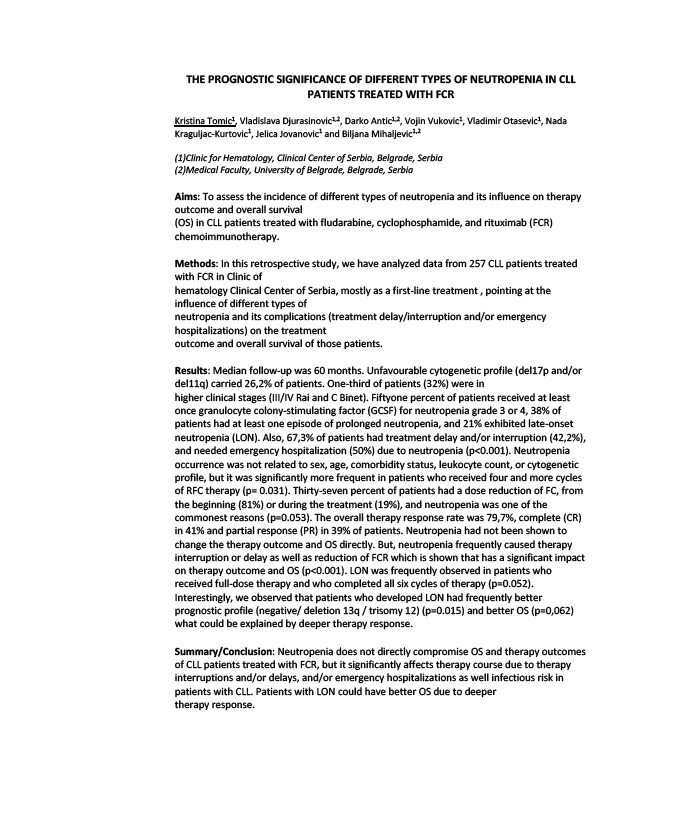
THE PROGNOSTIC SIGNIFICANCE OF DIFFERENT TYPES OF NEUTROPENIA IN CLL
PATIENTS TREATED WITH FCR
Kristina Tomic1, Vladislava Djurasinovic1,2, Darko Antic1,2, Vojin Vukovic1, Vladimir Otasevic1, Nada
Kraguljac-Kurtovic1, Jelica Jovanovic1 and Biljana Mihaljevic1,2
(1)Clinic for Hematology, Clinical Center of Serbia, Belgrade, Serbia
(2)Medical Faculty, University of Belgrade, Belgrade, Serbia
Aims: To assess the incidence of different types of neutropenia and its influence on therapy
outcome and overall survival
(OS) in CLL patients treated with fludarabine, cyclophosphamide, and rituximab (FCR)
chemoimmunotherapy.
Methods: In this retrospective study, we have analyzed data from 257 CLL patients treated
with FCR in Clinic of
hematology Clinical Center of Serbia, mostly as a first-line treatment , pointing at the
influence of different types of
neutropenia and its complications (treatment delay/interruption and/or emergency
hospitalizations) on the treatment
outcome and overall survival of those patients.
Results: Median follow-up was 60 months. Unfavourable cytogenetic profile (del17p and/or
del11q) carried 26,2% of patients. One-third of patients (32%) were in
higher clinical stages (III/IV Rai and C Binet). Fiftyone percent of patients received at least
once granulocyte colony-stimulating factor (GCSF) for neutropenia grade 3 or 4, 38% of
patients had at least one episode of prolonged neutropenia, and 21% exhibited late-onset
neutropenia (LON). Also, 67,3% of patients had treatment delay and/or interruption (42,2%),
and needed emergency hospitalization (50%) due to neutropenia (p<0.001). Neutropenia
occurrence was not related to sex, age, comorbidity status, leukocyte count, or cytogenetic
profile, but it was significantly more frequent in patients who received four and more cycles
of RFC therapy (p= 0.031). Thirty-seven percent of patients had a dose reduction of FC, from
the beginning (81%) or during the treatment (19%), and neutropenia was one of the
commonest reasons (p=0.053). The overall therapy response rate was 79,7%, complete (CR)
in 41% and partial response (PR) in 39% of patients. Neutropenia had not been shown to
change the therapy outcome and OS directly. But, neutropenia frequently caused therapy
interruption or delay as well as reduction of FCR which is shown that has a significant impact
on therapy outcome and OS (p<0.001). LON was frequently observed in patients who
received full-dose therapy and who completed all six cycles of therapy (p=0.052).
Interestingly, we observed that patients who developed LON had frequently better
prognostic profile (negative/ deletion 13q / trisomy 12) (p=0.015) and better OS (p=0,062)
what could be explained by deeper therapy response.
Summary/Conclusion: Neutropenia does not directly compromise OS and therapy outcomes
of CLL patients treated with FCR, but it significantly affects therapy course due to therapy
interruptions and/or delays, and/or emergency hospitalizations as well infectious risk in
patients with CLL. Patients with LON could have better OS due to deeper
therapy response.